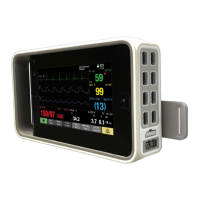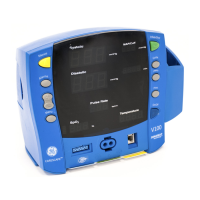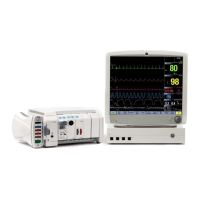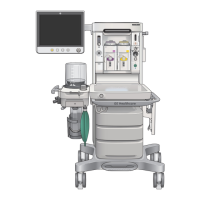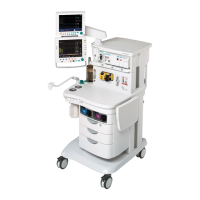Neuromusculartransmission
ChangingtheNMTcycletime
Thisselectionalsoaffectstherecoverynote.
1.SelecttheNMTparameterwindow>Setup.
2.SelectavaluefromtheCycleTimelist.
ChangingtheNMTpulsewidth
1.SelecttheNMTparameterwindow>Setup.
2.SelectavaluefromthePulseWidthµslist.
AdjustingtheNMTbeepvolume
Youcansetthebeepvaluetobestsuityourcareenvironment.
1.SelecttheNMTparameterwindow>Setup.
2.SelectavaluefromtheStimulusBeepVolumelist.
UsingtheNMTrecoverynote
TherecoverynotealarmsyouwithasinglebeepandtheBlockrecoverymessage
whenthecountreachesthevalueyouhaveselected.Itindicatesthatthepatientis
respondingmoreclearlytothestimuliandtheneuromuscularblockisdecreasing.
Thenoteisactivatedaccordingtothecountnumberandcycletime:
●Cycletimelessthanoneminute:Thecountmustbebelowtheselectedlimitin
twoconsecutivemeasurements.
●Cycletimeoneminuteormore,ormanualmeasurement:Atleastonecountmust
bebelowtheselectedlimit.
Totakethisfeatureintouse:
1.SelecttheNMTparameterwindow>Setup.
2.SelectRecoveryNote.
3.Selectthecountlimitthatwillactivatethenote.
Measuringdeeprelaxation
WhennoresponsesaredetectedforTOFstimulation,theposttetaniccount(PTC)is
theonlywaytomeasuretheneuromuscularblock.Atetanicstimulation(50Hz)is
generatedforvesecondsandpost-tetanicresponsestosingle-twitchstimulation
arecounted.ThelargerthePTC(thenumberofdetectedresponses),thesoonerthe
normalTOFresponsesreturn.Tomonitortherelaxationlevel,startave-second
tetanicstimulation:
1.SelecttheNMTparameterwindow>Setup.
2.SelectStartTetanic/PTC.
ContinuingtheNMTmeasurement
TocontinueinterruptedNMTmeasurementwiththesamepatientandmonitor,press
theStopContinuemodulekey,or:
1.SelecttheNMTparameterwindow>Setup.
366CARESCAPEModularMonitors2062971-001
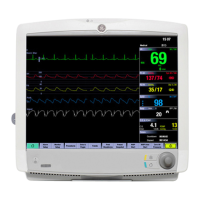
